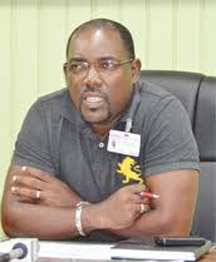General Manager of the Demerara Harbour Bridge Corporation (DHBC), Rawlston Adams said during a press conference on Friday that the Transport Ministry is working on a proposal for a new Demerara River crossing.
If completed, the thousands of Guyanese who depend on the existing bridge for the work commute and other reasons can look forward to more convenience and less hassle.

Adams, who made the announcement during the Ministry of Public Works 2012 overview press briefing, said some amount of research and conceptualization has already concluded that the second bridge would most likely be built in the same vicinity as the first.
Adams said that the idea to construct a second bridge resulted from a number of factors, including a massive influx of vehicles into the country, and the resulting traffic increase across the bridge. According to Transport Minister Robeson Benn, there are approximately ninety thousand vehicles in Guyana, the majority of which are owned by persons on the coast, many of whom use the DHB daily.
Adams stated that for the year 2012, the DHB saw a 6.5% increase in vehicular traffic and a 5.8% increases in marine transit, relative to 2011. He added that these figures do not take into consideration the potential traffic that would not have been able to use the bridge on the various days it was out of commission.
He said that these increases pose management issues since the bridge’s administrators have to find ways to ensure that both vehicular and marine traffic are accommodated by the bridge without one being overly inconvenienced by the other. Adams said that there is now an average of four marine vessels which pass the bridge daily, as opposed to the two in previous years. He said that this figure will more than likely increase the period of time the bridge is closed to vehicular traffic.
“2012 has been a mixed year for the DHB,” said Adams as he attempted to paint a picture of the bridge’s overall performance last year. He shared that the bridge has seen a 7.5% increase in revenue collected, which is most likely as a result of the increased amount of vehicles that traverse it.
Adams said that of the $270 Million in subventions allotted to the DHB by the Ministry for its current and capital projects, $268Million had been expended as of December 31st 2012. He said that with these funds, the DHBC was able to complete the majority of maintenance and other projects it had slated for 2012, although several are still ongoing, including the servicing of pontoons and the rehabilitation of cluster piles for the retractor span.
Most significant among completed works, said Adams, was the replacement of the hydraulic ramps for the bridge’s retractor span. He explained that the changing of the ramps, last done 15 years ago, took approximately seven days and entailed the occasional shutting down of the bridge.
Commenting on the challenges the bridge faced, Adams mentioned its partial submersion on July 23rd. Stabroek News had reported on July 23rd 2012 that the 60th and 61st pontoons of the bridge sunk which resulted in the submersion of the bridge’s sub-spans. Adams had explained that works being done to repair a severely damaged A frame required the positioning of temporary pontoons. He said that investigations revealed that the pontoons sunk after the jaws of their “unifloat” broke.
Adams said the bridge’s closure to facilitate repairs cost the DHBC approximately $3Million in revenue, and that the sunken pontoons had to be salvaged from the bottom of the river, so as to prevent any possible mishaps. He said that the salvage works cost the DHBC a further $15Million.
Adams also made mention of the October 1st incident where two fishing boats slammed into the bridge after a strong tide liberated them from their moorings at the Georgetown Ferry Stelling. Though the ensuing damage caused several inconveniences, he said that all necessary repairs have been done and the bridge has been functioning normally since.
As part of their 2013 projects, Adams said that the DHBC plans to fabricate up to four extra large pontoons.








